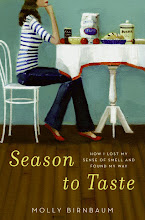 I think that am turning into a muffin.
I think that am turning into a muffin.I baked a plump batch of pumpkin muffins three days ago and now my muffin-consumption frequency has officially reached a dangerous level. In fact, as I made my way out of my apartment last night (after my fourth muffin of the day, yes) I glanced in the mirror and I’m pretty sure I could see the beginning traces of a pumpkin-orange hue emanating from my skin.
I am in the midst of a baking kick. It began a few weeks ago with a dinner party and an almond cake, moved along to bread, some batches of oatmeal cookies, and has now landed in the realm of muffins.
Perhaps this baking spree has something to do with the cooler weather, the encroaching holiday season. I love when my oven is full. And baking, comfort, home – they are all
 intertwined.
intertwined.Or perhaps it is more of this anniversary syndrome. One year ago, after all, I was working at the Bakery, hammering out apple pies and chocolate babka in the hectic ambush of Thanksgiving orders. When I got home each night my hands, despite numerous washings, felt constantly encased in a thin film of butter and phyllo dough. My lips always tasted of sugar. Those long hours I spent hunched over a large wood table in the bakery kitchen, carefully tracing lines of colorful frosting onto turkey-shaped sugar cookies are now speaking to my culinary subconscious.
This year I have yet to bake anything resembling a barnyard animal, thankfully, as that would be truly troubling. And despite my initial worry, I believe these vivid orange muffins – light, cakey and moist; with a subtle layer of sweetness – are worth the risk of over-consumption. If you had to transform into some non-human thing, I think that they are an excellent choice. I suppose as a pumpkin muffin you wouldn't be able to turn the pages of the book you're reading, ride a bike in the park, or see over the seat in front of you at the movie theater. But, no matter what, you would be an excellent companion to a steaming mug of ginger tea, a bit of Miles Davis, a rainy evening, and a writing project to complete at my desk.

Pumpkin Muffins
adapted from Gourmet Magazine, November 2006
1 1/2 cups flour
1 teaspoon baking powder
1 cup canned solid-pack pumpkin
1/3 cup canola oil
2 large eggs
1/2 teaspoon cinnamon
1/4 teaspoon nutmeg
1/4 teaspoon allspice
1/4 teaspoon ground ginger
1 cup sugar
1/2 teaspoon baking soda
1/2 teaspoon salt
-Preheat oven to 350 F.
-Whisk together flour and baking powder in a small bowl.
-Whisk together pumpkin, oil, eggs, spices, sugar, baking soda and salt in another, larger bowl. Once smooth, whisk in the flour until just combined.
-Butter a muffin pan and divide the batter evenly into each inlet (should make 12 muffins).
-Bake for 25-30 minutes, until puffed and golden. A toothpick stuck into the center should come out clean.
-Let rest in the pan for five minutes, and then take out the muffins and allow them to cool on a rack until at room temperature.









